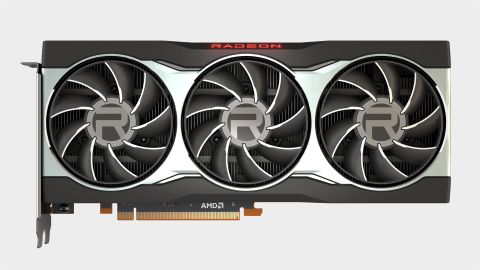Our Verdict
The RX 6800 has no real opposite number over at Nvidia, but I can say it more than matches an RTX 2080 Ti at 4K and over delivers at 1440p for high refresh rate gaming without compromise.
For
- 1440 performance
- Capable at 4K
- Large GDDR6 capacity
Against
- Moderate ray tracing performance
- More expensive than an RTX 3070
- No DLSS alternative at launch
PC Gamer's got your back
The AMD RX 6800 is the more affordable of the RDNA 2 graphics cards launching this year, coming in beneath the AMD RX 6800 XT and the RX 6900 XT. That doesn't necessarily a cheap GPU make, as even the RX 6800 is priced at $579. But here's why you might want to consider AMD's third-tier RDNA 2 card anyways: It absolutely kills at 1440p.
Ah, I've spoiled the surprise. But let's not get ahead of ourselves. There's plenty to talk about with the RX 6800, and not the least bit how it stacks up versus the only competition it has right now: the Nvidia RTX 3070. That's a battle easily won in raw game performance, but perhaps it's also a little unfair to compare the two, considering one is $80 cheaper and hardly the RX 6800's opposite number—that's a position not yet filled by any Nvidia RTX 30-series graphics card currently announced.
This card has to a lot to offer in its own right, however. Perhaps the most immediately staggering of its specs is the 16GB of GDDR6 memory AMD is bringing to bear in a market usually underserved in VRAM capacity, at least when stood next to the best of the best, and those datacentre graphics cards with their gargantuan buffers.
And while the RX 6800 isn't 'Big Navi', per se—that accolade goes to the 80 compute unit (CU) RX 6900 XT—it's not exactly 'Little Navi', either. Though I suppose that one goes to the 20 CU Xbox Series S. Or at least until some RDNA 2 makes its way into budget-friendly graphics cards and next-gen APUs.
The RX 6800 is fit with a total of 60 CUs and 3,840 stream processors, which makes it a size above the RX 5000-series GPUs, including AMD's previous high-end incumbent, the RX 5700 XT, with its 40 CUs.
But there's a lot more to the RX 6800 than just a scale up of core counts. With commonalities across the entire RX 6000-series range right now, you can be sure that no matter which card you pick up that you're getting a fully realised vision of the RDNA 2 architecture within it—Infinity Cache and all.
AMD RX 6800 specifications
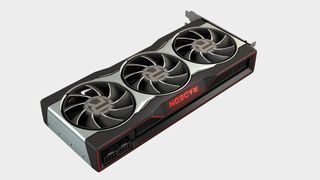
AMD RX 6800 specifications
The AMD RX 6800 comes with a Navi 21 GPU of near-enough the same ilk as the RX 6800 XT and RX 6900 XT. It's separated from the RX 6800 XT by just 12 CUs: the RX 6800 comes with 60 CUs to the RX 6800 XT's 72. It's the largest core disparity so far announced in the RX 6000-series lineup, but even so is not hugely disparate from its bigger siblings.
It clocks in with a 1,815MHz game clock, which can boost upwards of 2,105MHz. As with other AMD cards in the RDNA 2 lineup, and even the competition, this is not necessarily the final clock speed you'll find your card to run at under duress from the latest games. In fact, you'll often see it creep plenty higher.
In the RX 6800's case, that's in large part to the power optimisations that AMD has rolled out with the RX 6000-series in order to raise the bar for performance up into the enthusiast grade and 4K gaming. Some clever tweaks, many of which actually originate from Ryzen CPU R&D, help both the RX 6800 XT and RX 6800 break 2GHz with relative ease, and even creep up to the 2.5GHz barrier at times. The RX 6800 is again the slower card out of the lot, but not by much.
At least for its more circumspect clock speed we see a reduction in TGP from the two 300W cards above it. The RX 6800 runs at 250W TGP, or what AMD calls TBP. Either way, it's in reference to the total power drawn by the graphics card and not just the GPU alone.
I've detailed the RDNA 2 architecture over in our AMD RX 6800 XT review, and so I'll save you an eyeful here. What you need to know is that the second-generation RDNA gaming architecture at the core of the RX 6800 is more power efficient than ever, incredibly fast, and comes with new exciting hardware blocks in the Ray Accelerators and Infinity Cache.
GPU - Navi 21
Lithography - TSMC 7nm
Die size - 519 mm2
Transistors - 26.8bn
Stream processors - 3,840
CUs - 60
Ray Accelerators - 60
GPU Game clock - 1,815MHz
GPU Boost clock - 2,105MHz
Memory bus - 256-bit
Memory capacity - 16GB GDDR6
Memory speed - 16Gbps
Memory bandwidth - 512GB/s
TGP - 250W
Recommended power supply - 650W
Size - 2-slot
Price (reference) - $579
It's the Infinity Cache that stands out as the most important of the two, though I do love shiny things. We'll touch on ray tracing performance later, don't you worry. For now, it's the less immediately noticeable, but seemingly more important, Infinity Cache block on die that naturally acts as a performance boon for the RX 6000-series overall.
That's because the RX 6800, while fit to burst with 16GB of GDDR6 memory, only comes with a 256-bit memory bus to access it. That's 512GB/s in total. To generate more memory bandwidth without implementing a larger memory bus, AMD uses its 128MB Infinity Cache—an innovative new cache system just off the main shader engines inspired by none other than AMD's own EPYC server chips.
In the case of the RX 6800, that's especially useful for the 1440p performance it targets. The Infinity Cache is more likely to store the data required by the GPU at lower resolutions, though if you drop it down to 1080p you're actually less likely to be limited by memory bandwidth. So somewhere in between 4K and 1080p the resolution porridge is just right.
The RX 6800 is more than capable of decent 4K performance, too, if you so wish. That sees it as a torpedo aimed straight at the RTX 3070 and even RTX 2080 Ti, two cards that similarly straddle the two resolutions as a fairly good fit for either.
But where you'd expect a direct clash between AMD and Nvidia's third-run GPUs, that's actually not quite the case. The RX 6800 is priced at $579, which is nothing shy of a considerable price increase over the $499 RTX 3070. As such, our expectations were set a little higher of the RX 6800—about 80 bucks worth more.
But as you'll see in the performance figures below, the RX 6800 still makes a great case for loosening your purse strings.
AMD RX 6800 performance
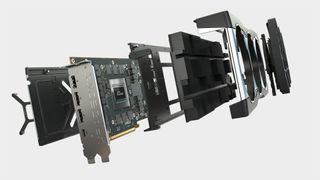
AMD RX 6800 performance
While the RX 6800 might be a fantastic fit for 1440p, as you'll see below, there's a strong case to be made for it as a performant 4K graphics card, too. So long as you promise to lay off the ray-traced reflections and ambient occlusion, that is.
Perhaps it's the generous 16GB memory buffer that does it, or the fact the RX 6800 can maintain a steady gait over 2GHz with relative ease. Either way, the RX 6800 is more than capable of holding its own.
And it's confidently ahead of the RTX 3070 in nearly every race, if you're wondering. As you'd hope, and most likely expect, from a graphics card at an $80 premium.
4K gaming performance









Frame rates upwards of 60 are hardly guaranteed at 4K at ultra or very high settings with the RX 6800, but they're not often too far off. Certainly within the realms of possibility for the third-tier RDNA 2 graphics card, at least.
And if there's any consideration for the RTX 3070 as a possible 4K freighter then you can only say the same but more so for the RX 6800. Surpassing the RTX 3070 by anything from low single-digit to around 20 percent at 4K, it's unquestionably a more deft hand at 4K.
Perhaps the most likely workload to be memory constrained, at least in gaming terms, the RX 6800 has a proclivity towards advantage at this resolution due to its 16GB of GDDR6 , double that of the RTX 3070. That memory advantage would also explain how the RX 6800 manages to maintain a pace slightly above the RTX 2080 Ti—you know, that all-powerful 4K god-tier card from just two years ago?
That little piece of fun comparative trivia certainly helps cement the RX 6800's place as a more than capable 4K graphics card.
1440p gaming performance








Yet even a confident swing at 4K doesn't change my mind: This is an immensely capable 1440p card. It's a graphics card perfectly aligned to delivering high refresh rates with the popular PC panel resolution, and thus the best able to take you right into the sweet-spot... ugh, no.
It's at 1440p that the RX 6800 utterly destroys the RTX 2080 Ti. Once again a healthy dose of memory capacity is sacred word for gaming performance, but there's likely more to it than that. The Infinity Cache at the core of the RX 6800 functions best at 1080p and lower resolution, although at that resolution you're unlikely to see a tremendous benefit from such a cache subsystem as your memory buffer chugs along just fine regardless. So it's not actually as valuable to gaming performance at 1080p, per se.
At 1440p, however, we're seeing less of a lopsided demand for either memory bandwidth or GPU speed and capability. Both play a pivotal role at 1440p, of course, but, in requiring a dollop of both in good quantity, we're seeing the RX 6800's heady blend of both engine and memory coming into its own.
1080p gaming performance








O, 1080p—a resolution so easy-going for any and all of the latest graphics cards from AMD or Nvidia that you could pick one at random and be hard-pressed to say which card you were gaming on in without peaking behind the curtain.
Still, it's the overwhelmingly dominant resolution today, and even with 1440p and 4K on the rise there will always be games where speed trumps quality.
At 1080p, we actually see the RX 6800 fall back from its lead at 1440p by a large margin. Aside from F1 2020, which apparently absolutely adores memory, both the RTX 3070 and RTX 2080 Ti manage to catch up. Not always, of course, but often.
With an Intel Core i7 10700K in the test rig, we're not looking at a significant bottleneck, but there's certainly less focus on the GPU to deliver frame after frame. It's something to consider if you're primarily a 1080p gamer and looking for a graphics card that can help you break the 240Hz, or even 360Hz, limit on your gaming monitor—there's a little more too it than a high-end graphics card and calling it a day.
Still, the RX 6800 does maintain a lead over the RTX 3070 and RTX 2080 Ti at 1080p, so there's certainly not a bad word to be said about it nonetheless.
Ray tracing performance


The RX 6800 never really stood a chance against the new and improved RT Core and Tensor Core combo in the RTX 3080. In fact, it's the one benchmark where the RX 6800 is decisively down on both the RTX 3070 and RTX 2080 Ti—they both just have better RT chops.
AMD's Ray Accelerator hardware block—one per CU—is a decent enough approach for moderate ray tracing success in practice, but when Nvidia has just made quite a splash by negating the impact of ray tracing with second-gen Ampere acceleration silicon, the bar was set uncomfortably high for RTG with its first-gen approach.
Perhaps that's why AMD's not so keen to scream and shout about ray tracing just yet. There's hope for some tailor-made ray tracing experiences later in life—after all, the Xbox Series X, Series S, and PlayStation 5 all contain the same Ray Accelerator blocks—but we suspect even those will require a light touch on PC, especially when compared to Nvidia's RTX suite fully-enabled, DLSS and all.
Power and thermal



CPU - Intel Core i7 10700K
Motherboard - MSI MPG Z490 Gaming Carbon WiFi
RAM - Corsair Vengeance RGB Pro @ 3,200MHz
CPU cooler - Corsair H100i RGB Pro XT
PSU - NZXT 850W
Chassis - DimasTech Mini V2
The RX 6800, perhaps unsurprisingly, is one of the coolest and most power efficient graphics cards today. At 0.54 Frames/J at 1080p (J for Joules, a measure of one Watt dissipated as heat over one second), RDNA 2 is far out in front of the pack as the most energy efficient architecture when kept to a modest TGP of 250W. The RTX 3070 is the only one to get anywhere close to that grade at 0.48 Frames/J.
The cooler is similar by design to the one strapped to the RX 6800 XT, only marginally more slight in standing. The size of the heatsink separates the two, with the RX 6800 fitting into a neat 2-slot size and the RX 6800 XT requiring 2.5-slots worth of real estate.
It's a proven cooler design, too, at just 69°C average temperature and 71°C peak.
Overclocking and undervolting







A brief stint overclocking using the tuning tab in the Radeon software proved much the same as it did with the RX 6800 XT: play it safe with a stable 156Mhz GPU clock increase (taking the RX 6800 to 2,350MHz), paired with a judicious 15 percent power limit for wiggle room, and you'll find a moderate bump of a frame or two across the board.
There's certainly more to be gained with some more granular tweaking, I'm sure of it, as even my quick and dirty OC managed to turn up some promising results.
There's no Rage Mode with the RX 6800, so it's either void your warranty or leave your card at stock—your choice.
But let's not forget undervolting, a fan favourite for red team cards. Undervolting also seems a viable option on the RX 6800, too, although my experiment turned up a slight performance dip at the recommended 1000mV setting (-25mV from stock) prescribed to me via the AMD Radeon Software tuning tab. In return, power demands dropped, both over time and at peak, and GPU temperature dropped 3°C on average.
Worth it? Probably not, but again there's likely a more fine-tuned mix to unlock the best blend of both worlds. And you never know what the silicon lottery may have in store for you.
AMD RX 6800 verdict
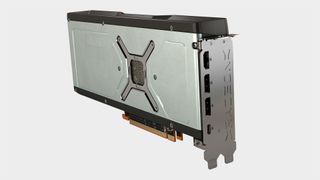
AMD RX 6800 verdict
The RX 6800, as the only RX 6000-series not to arrive cheaper than its rough counterpart in Nvidia's RTX 30-series, has been the most difficult to judge of the three red team propositions.
While the RX 6800 might be a fantastic fit for 1440p, there's a strong case to be made for it as a performant 4K graphics card, too
What is clear cut from my time with the RX 6800 is that it delivers superior performance to the RTX 3070 on almost every occasion—and by some margin. The RX 6800 offers convincing performance at 1080p through 4K, anywhere from a couple of percent to a double-digit advantage in the red team's favour. Even the RTX 2080 Ti often crumbles in the face of the RX 6800.
Is that margin worth $80? Yes, in many cases, but there are some notable boons to the RTX 3070 package that are either missing, or temporarily absent, from the RX 6800. DLSS, for one, is a sure-fire way to deliver frame rates far in excess of native resolution rendering in supported games, and that list of DLSS-compatible games is growing. AMD's yet to make its FidelityFX Super Resolution plans clear.
Similarly, ray tracing performance is far off the mark of the RTX 3070. AMD's Ray Accelerators are a capable solution for lessening the burden of the holy grail of rendering tech but it's hardly negated the workload as Nvidia's Ampere graphics cards have.
Nvidia's on a better footing when it comes to feature support as it stands today, and that could easily eat away at $80 worth of extra frames in terms of relative value if you're inclined to put either ray tracing or super sampling tech to good use. In regards to the latter, there's little reason not to when available.
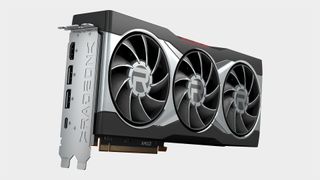
If you're looking for a little more power, or you're simply curious as to what RDNA 2 can offer with a bigger power budget, check out our RX 6800 XT review.
But DLSS isn't ubiquitous. And a near complete sweep of impressively faster frame rates than both the RTX 3070 and RTX 2080 Ti is proof enough that there's certainly value in spending another $80 on the RX 6800. It's difficult to chastise a card for being better, right?
As such, the RX 6800 is just as much a excellent graphics card as we had hoped for, if only for a little more money than we had expected of any third-run chip this generation. But perhaps that's more proof that the RX 6800 was never really a match for the RTX 3070, and is simply a card without any real counter from the green team today.
It also sits just $70 cheaper than the vastly-superior RX 6800 XT. A significant sum more to spend for any potential RTX 3070 customer, sure, but if you're eyeing up one of AMD's RX 6000-series cards then the potential for significantly greater performance at just $70 will have most PC builders setting their aspirational sights on the high-end RTX 3080-abating RX 6800 XT.
But the RX 6800 is just about a decent deal today, and that's all that I should consider for this review, but there's still that little voice in the back of my mind that says Nvidia is going to respond with something that makes the RX 6800 a much harder sell in the near-future—and it feels like AMD's left the door open pretty wide for just such a move.
But I'm not going to pretend to infer the machinations of any GPU manufacturer on hunch alone. For now, the RX 6800 is the most affordable RDNA 2 GPU, bar a next-gen console, and it's just as much an excellent graphics card within its limits as the exciting new architecture permits further up the stack.
Just look at those 1440p numbers—AMD's third tier RDNA 2 graphics card makes the RTX 2080 Ti look bad.
The RX 6800 has no real opposite number over at Nvidia, but I can say it more than matches an RTX 2080 Ti at 4K and over delivers at 1440p for high refresh rate gaming without compromise.

Jacob earned his first byline writing for his own tech blog. From there, he graduated to professionally breaking things as hardware writer at PCGamesN, and would go on to run the team as hardware editor. He joined PC Gamer's top staff as senior hardware editor before becoming managing editor of the hardware team, and you'll now find him reporting on the latest developments in the technology and gaming industries and testing the newest PC components.
